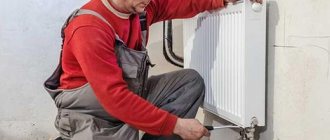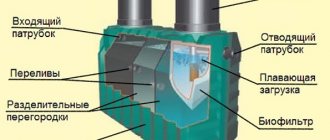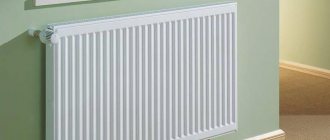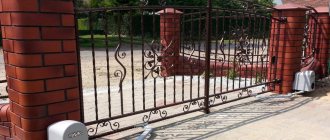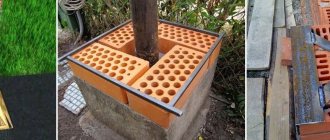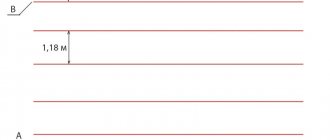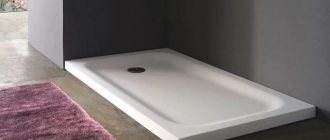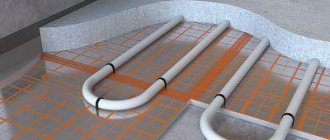Radiators with bottom connection
You can hide bulky pipes by making heating with a bottom connection. Of course, standard systems are more familiar to understand, when the coolant enters from the top or side and exits downwards. But such a system is rather unaesthetic, and it is difficult to cover it with a screen or somehow improve it.
Bottom connection principle
The scheme with a bottom connection of heating pipes is not familiar and widespread, as it is less efficient.
than standard connections. But in some cases, this is a winning option. For multi-apartment apartments, such piping is not used. Most often, this type of connection can be found in private homes where aluminum and bimetallic heating radiators are used. With a bottom connection, the main part of the pipes is hidden under the floor covering, sometimes causing difficulties during seasonal inspection or preventative repairs. But there are also advantages - there is a minimum of complex bends or joints, which reduces the risk of leaks or accidents.
The connection diagram for heating radiators with a lower type is simple - the return and coolant supply pipes are located nearby, in the lower corner of the radiator. It is also possible to connect pipes from different sides of the radiator. The upper holes (if any) are screwed in with a plug.
The radiator installation kit is identical to the standard one:
For the bottom connection, it is best to use bimetallic radiators. they are strong, durable, and have excellent heat transfer due to heating, radiation and convection. Even when using a lower connection, heat loss will not be more than 15 percent. Thanks to the supply of hot coolant from below, the bottom of the battery heats up and warms up the top by convection.
Selection and installation of radiators
Bimetallic heating radiators are recommended for bottom connections; they are easy to assemble, install and repair. Radiator sections can be removed, added, or replaced if damaged.
When purchasing, it is better to give preference to domestic manufacturers; it is important to check the integrity of the battery and packaging. Documentation must be clear and written in Russian
Before installation you need to make markings. it is done with a pencil on the wall. In this case, the points where the brackets will be installed are marked. The bottom of the radiator should be at least 7 cm from the floor and 10 cm from the window (if located under the window). Distances are maintained so that the air in the room circulates freely. The distance to the wall should be about 5 cm.
For more efficient coolant circulation, heating radiators are installed with a slight slope. This also eliminates the accumulation of air in the heating system.
When connecting, it is important to follow the markings and not confuse the return and supply. If connected incorrectly, the radiator can be damaged and its efficiency reduced by more than 60 percent
The following types of bottom connection are distinguished:
- one-sided supply - pipes come out from the corner below and are located side by side, heat loss can be about 20 percent;
- versatile supply – pipes are connected from different sides. such a system has more advantages, since the length of the supply and return lines is shorter, and circulation can occur from different sides, heat loss is up to 12 percent;
A top-down connection is also used. but in this case, it will not be possible to hide all the heating pipes, since the coolant will be supplied in the upper corner, and the outlet will be from the opposite lower corner. If the heating radiator is a short-circuit one, then the return flow will be discharged from the same side, but from the lower corner. In this case, heat loss is reduced to 2 percent.
If you plan to connect heating radiators yourself, it is important to follow installation and safety precautions. The coolant must be drained during installation or repair, the batteries are cold
If in doubt, it is better to call a specialist or use a training video lesson, since with a lower connection it will be difficult to repair areas. It is better to plan a heating system with bottom heating together with the layout of the house.
How to determine the number of sections
The main parameter for calculations is the amount of heat required to heat the room. When connecting additional sections, one requirement must be met: the battery should not protrude beyond the window opening.
When calculating the number of elements, the following must be taken into account:
- climatic operating conditions;
- what heating system is used - autonomous or centralized;
- quality of the coolant used;
- category of the room, degree of insulation and possible leaks;
- room volume.
To calculate and determine the total number of sections in the batteries, it is first necessary to determine what total amount of heat is needed to heat a particular residential property. This value can be determined based on building codes and regulations (SNiP), taking into account all the operating conditions given above.
It should be noted that the size of a room can be determined by two measurement systems, which include area and volume. Therefore, different options are used to determine the required amount of heat.
Calculations using the volume of the room are considered more accurate. First, the volume of the room is determined. In accordance with the requirements of SNiP, to heat one cubic meter of space, 41 Watts are needed for panel houses and 34 Watts for brick ones. The indicated values are very relative, so they can fluctuate over a wide range. To take into account circumstances affecting the calculation, it is necessary to use various correction factors.
The total amount of consumed thermal energy is determined by the product of the heat standard (according to SNiP) and the volume of the room. To reduce the error in calculations, this value is multiplied by correction factors.
Some indicators for correcting calculations:
- conventional glazing - magnifying factor is 1.27;
- reduced thermal insulation of walls - increasing 1.27;
- the number of window openings in the room is more than 2 - increasing 1.75;
- in a scheme with lower wiring - increasing 1.2;
- the use of insulating materials with improved characteristics - a reduction factor of 0.85;
- windows made of special heat-insulating double-glazed windows - reducing 0.85
Mandatory data for calculating the required number of sections is the heat transfer parameter of one link, the value of which must be indicated in the technical documentation. Taking into account all the data, we make the calculation:
There is another method for determining the number of sections, which is almost no different from the previous one. To carry out calculations, you will need to know the area of the heated building. When making calculations, it must be taken into account that the ceiling height on average should not exceed 2.7 meters. SNiP specifies the minimum heat transfer rate per square meter. In this case it is 100 watts.
Then the total number of sections can be calculated using the following formula:
N=S × 100/P
Where:
- N is the total number of sections in the battery;
- S is the area of the room;
- P is the power of one section (indicated in the product passport).
Let's calculate the number of sections in a battery for heating a room in a brick building, the area of which is 15 square meters, and the height to the ceiling is 3 meters. Let the power of one radiator section be equal to 140 watts, the heat standard, according to SNiP, will be 34 watts. The calculations use the method using the volume of the room.
Determine the number of sections:
- volume = 15 m2 × 3 m = 45 m3;
- required amount of heat = 45 m3 × 34 W = 1530 W;
- number of sections = 1530 W / 140 W = 10.7 pcs, if you round up, you get 11 pcs.
The problem of choosing radiators
There is no universal solution today. Different problems require different solutions.
For example, using aluminum radiators in apartments designed for centralized heating is a bad idea:
- Aluminum is a soft metal and may simply not withstand large differences in coolant pressure.
- The steel from which the pipes are made for passing coolant through them to the batteries gradually reacts with hot water under high pressure. The resulting salt solution interacts intensely with aluminum.
- Aluminum itself is not an inert material at all. At the point of contact with steel, noticeable corrosion reactions occur. The fact is that aluminum and unalloyed steel make up a so-called galvanic couple, that is, damage at the point of contact of these two metals is only a matter of time.
Bimetallic batteries are free from all of the following disadvantages:
- Their strength is such that radiators are guaranteed to withstand five times the coolant pressure of 10 atmospheres typical for centralized networks.
- Excellent appearance and a wide variety of shapes and sizes.
- Mounting bimetallic radiators will be more difficult than aluminum ones, but not much - with comparable dimensions, a bimetallic radiator will be about one and a half times heavier than a pure aluminum one.
Today, bimetallic radiators are used, made using two technologies:
- Steel frame - the coolant circulates through steel pipes and does not come into contact with aluminum. The “aviation” metal only covers the steel pipes to improve convection and the appearance of the batteries.
- Reinforced channels - uses the principle of reinforced concrete (two materials complement and reinforce each other). Using this technology, aluminum pipes are reinforced with steel inserts in critical areas. You should be aware that if installed incorrectly, these inserts can block the lumen of the pipe.
A peculiarity of the operation of bimetallic radiators is the characteristic tapping sound when heating and cooling the batteries (read: “Bimetallic heating radiators: which ones are better to choose”). The fact is that aluminum and steel expand differently, so there are stresses at the point of contact.
Dismantling an old radiator
In general, the process of disassembling an old cast-iron heating radiator is carried out in exactly the same way as a new one. But the problem is that over time, all connections become covered with scale and practically solder to each other. As a result, it becomes simply impossible to get by with just a plumbing radial wrench.
In addition, an additional item appears in the work - washing. The old radiator, in any case, is clogged from the inside with all sorts of dirt. Therefore, if you have already decided to improve it. then you need to take care of cleaning the equipment, this will allow it to work much longer and better.
It is advisable to wash it outside, this way you will protect the bathtub from damage. The procedure is carried out using ordinary running water, there is nothing complicated about it. But the further process can be very puzzling. If you find that the nuts have become firmly attached to the radiator and do not want to be separated from it, then you can use three different methods to break this union:
- The stuck compound can be separated using heat. To do this, you will need either a blowtorch or a hair dryer. The first option is much more efficient, but the second can also give the desired result. Using this auxiliary equipment, warm up the perimeter of the joint you need, and then immediately try to remove the nut without waiting for it to cool down. If it doesn’t help right away, repeat the same procedure several more times, after each attempt trying to figure out the problem again. Please note that working with hot metal is very dangerous. do not forget to protect yourself with protective clothing - mittens and an apron - and special glasses;
- If the previous procedure did not help, then you will have to try to solve the problem using a more radical method - cutting. The tool for this you will need is a hacksaw or a Bulgarian saw. The grinder does an excellent job of sawing metal, but here again you should take into account the fragility of the cast iron battery - if you cut in the same place for too long, the material may simply crack, and you will have to throw out the entire radiator. To prevent this from happening, you should make cuts in stages, giving the battery a little rest after each use. But in general. If you have the opportunity to spend a significant amount of time and effort, then it is better to use a hacksaw for cutting. Of course, this is a much more tedious and lengthy process than in the case of an angle grinder. But there is no risk of damaging the radiator in places where it is not required at all;
- the third option is even more brutal. If heating does not help solve the problem, and cutting is impossible for some reason, then there is only one way out - simply break the required section. This is done using a sledgehammer. Naturally, you shouldn’t hit it as hard as you can, because in this case you will be left without a battery. You need to act carefully and slowly, starting from the middle of the section and gradually reaching the point of its connection with the neighboring one. As with a blowtorch, be sure to wear safety glasses—even if you break it carefully, there is a risk that some of the pieces will bounce off sharply.
Dear readers, now you know how to properly disassemble a cast-iron battery, even if it is three times older than you and fiercely wants to maintain its integrity. Assembly is carried out, in general, in exactly the same way, but in reverse order.
Even if the radiator is completely new, all connections must be thoroughly cleaned with sandpaper before assembly. And in the case of an old battery, this is generally a mandatory procedure. In addition, it is advisable to replace all gaskets. If you had rubber ones before, then replace them with more modern ones made of silicone or paronite. These materials are much less susceptible to deformation and have a very long service life.
As you already understand, the most important thing in the process of disassembling a cast iron radiator is accuracy. The fragility of the material requires an extremely leisurely approach. In addition, do not forget about safety, which, as we know, comes first
With the right approach to the process, your cast iron radiator will serve for a long time and with high quality. Good luck!
In addition, do not forget about safety, which, as we know, comes first. With the right approach to the process, your cast iron radiator will serve for a long time and with high quality. Good luck!
What is needed for installation
Installation of heating radiators of any type requires devices and consumables. The set of necessary materials is almost the same, but for cast iron batteries, for example, the plugs are large, and they do not install a Mayevsky valve, but instead, somewhere at the highest point of the system, they install an automatic air vent. But the installation of aluminum and bimetallic heating radiators is absolutely the same.
Steel panel ones also have some differences, but only in terms of hanging - they come with brackets, and on the back panel there are special arms cast from metal, with which the heater clings to the hooks of the brackets.
Mayevsky crane or automatic air vent
This is a small device for releasing air that may accumulate in the radiator. Placed on the free upper outlet (collector). It must be on every heating device when installing aluminum and bimetallic radiators. The size of this device is significantly smaller than the diameter of the manifold, so you will also need an adapter, but Mayevsky taps usually come complete with adapters, you just need to know the diameter of the manifold (connection dimensions).
In addition to the Mayevsky crane, there are also automatic air vents. They can also be installed on radiators, but they are slightly larger in size and for some reason are only available in a brass or nickel-plated case. Not in white enamel. In general, the picture is unattractive and, although they deflate automatically, they are rarely installed.
Stub
The side-connected radiator has four outputs. Two of them are occupied by the supply and return pipelines, on the third they install a Mayevsky valve. The fourth entrance is closed with a plug. It, like most modern batteries, is most often painted with white enamel and does not spoil the appearance at all.
Shut-off valves
You will need two more ball valves or shut-off valves that can be adjusted. They are placed on each battery at the input and output. If these are ordinary ball valves, they are needed so that, if necessary, you can turn off the radiator and remove it (emergency repairs, replacement during the heating season). In this case, even if something happens to the radiator, you will cut it off, and the rest of the system will work. The advantage of this solution is the low price of ball valves, the disadvantage is the impossibility of adjusting heat transfer.
Almost the same tasks, but with the ability to change the intensity of the coolant flow, are performed by shut-off control valves. They are more expensive, but they also allow you to adjust the heat transfer (make it less), and they look better externally; they are available in straight and angular versions, so the piping itself is more accurate.
If desired, you can install a thermostat on the coolant supply after the ball valve. This is a relatively small device that allows you to change the heat output of a heating device. If the radiator does not heat well, you cannot install them - it will be even worse, since they can only reduce the flow. There are different thermostats for batteries - automatic electronic ones, but more often they use the simplest one - mechanical.
Related materials and tools
You will also need hooks or brackets for hanging on walls. Their number depends on the size of the batteries:
- if there are no more than 8 sections or the length of the radiator is no more than 1.2 m, two mounting points on top and one on the bottom are sufficient;
- For every next 50 cm or 5-6 sections, add one fastener at the top and bottom.
You also need fum tape or linen winding and plumbing paste to seal the joints. You will also need a drill with drills, a level (preferably a level, but a regular bubble one will do), and a number of dowels. You will also need equipment for connecting pipes and fittings, but it depends on the type of pipes. That's all.
Self-installation of sectional heating batteries
Before installing the radiator, the surface of the wall that will be behind it must be plastered and puttied. After this, it is recommended to stick a sheet of foil insulation on it, corresponding to the size of the heating device.
During the finishing process, the reflective surface can be wallpapered, painted or tiled - the foil will still provide heat reflection towards the living space.
Necessary tools and additional materials
To perform installation work on installing sectional bimetallic heating radiators, you must prepare:
- adjustable wrench;
- hammer drill or impact drill;
- Popov pipe wrench (ass);
- building level;
- tape measure and pencil;
- radiator wrench with 24 mm end blade;
- a set of end plugs with a plug and a Mayevsky tap;
- ball valve ½ inch with detachable connection, external and internal threads;
- faucet regulator for thermal head;
- radiator gaskets;
- combed flax (tow);
- plumbing silicone or investment paste.
Depending on the installation method, fastening elements can be wall-mounted or floor-mounted. In the first case, you need 4 of them, in the second - 2.
Repacking radiator sections
Before installing the battery in place, it is necessary to assemble the device with the estimated number of sections. The factory equipment includes sets of 10 elements. Therefore, in most cases, you will have to separate or add a few pieces. This is done using a special radiator key, the length of which is at least 8 sections, and the width of the end blade is 24 mm.
Look at the thread direction on one of the radiator end holes. Insert the key inside so that the key blade is in the joint area between the sections to be separated. Turn the key in the opposite direction from the thread direction. The moment the elements separate is usually accompanied by a click.
Adding the removed sections to another set is done in the reverse order.
Options for connecting the heating device to the distribution pipelines
After repacking is completed, plugs, shut-off valves and an air release valve are installed on the battery. The method of connecting a bimetallic heating radiator in an apartment is determined by the type of piping system, which can be:
- saddle;
- diagonal;
- one-sided.
In the first case, shut-off valves are installed on both sides of the device, in the holes of the lower plugs, and the Mayevsky valve is installed in the upper one, further along the coolant flow. The name of the second piping option determines the installation of fittings in the upper and lower plugs located diagonally on the radiator.
A one-way connection scheme is used for single-pipe vertical risers of multi-storey buildings. In this case, the taps are mounted at the top and bottom on one side of the battery.
Installation of a bimetallic radiator on the wall
After repacking the sections and installing shut-off and control valves, you can begin installing the heating device in its intended place. In this case, the procedure for doing it yourself is as follows:
- measure the distance from the bottom edge of the section to the center of the upper nipple connection and add 100-120 millimeters to this value;
- make a mark on the wall at the height of the measurement taken;
- draw a horizontal line passing through the mark you made earlier;
- on this line draw the position of the middle of the window;
- take a measurement between the nipples of the penultimate sections of the radiator at the edges, divide the result by two and put it along a horizontal line in both directions from the center of the battery;
- measure the distance;
- from the obtained marks, vertically downwards, set aside the distance corresponding to the measurement between the centers of the section nipples (usually 500 or 300 mm);
- drill 4 holes according to the marks obtained, insert plastic plugs into them and screw the hinged fasteners into the threads;
- hang the radiator on the installed supports.
After this, you need to measure the distance from the battery to the wall and check the horizontal position of the upper plane of the device with a level. If necessary, the fasteners should be unscrewed or tightened, and the horizontal installation should be adjusted by bending the installed supports up or down.
Floor installation of heating radiators
This type of installation of radiators is used in the absence of a strong load-bearing wall. This happens when constructing window openings up to floor level, display railings, or covering the surface with plasterboard slabs at a significant distance (more than 200 mm) from the main walls.
Floor mounts are a metal support structure in the shape of the letter “H” with a lower transverse bar for screwing to the surface. They are manufactured in two versions:
- from steel angle;
- from bent profile pipes.
The easiest way to install a heating device without fixing it to the wall is as follows:
- take 2 fasteners and simply put them on the radiator from below;
- place the device together with fasteners at its installation location;
- ask an assistant to hold the battery and make marks on the floor through the holes in the bottom bar;
- remove the fasteners, drill holes and screw the support to the floor using dowels.
It is recognized that floor installation of radiators is less reliable than wall-mounted installation. But there are options that this will be the only possible solution for heating the room. An alternative can only be heated floors.
Installation of bimetallic batteries
It clearly describes the procedure for connecting bimetallic heating radiators for a specific model. It should be noted that the installation of all system elements is carried out in plastic packaging of the radiator. And this packaging cannot be removed until the entire installation process is completed.
Let's look at how to connect a bimetallic heating radiator yourself. When carrying out installation work, the following nuances must be taken into account:
- It is better to place the battery in the center of the window;
- equipment is installed only in a horizontal position;
- heating parts must be installed at the same level within the room;
- the distance from the wall to the battery should be from 3 to 5 cm. If the heating system is located too close to the wall, the thermal energy will be distributed irrationally;
- a distance of 8-12 cm must be maintained from the window sill. If the gap is too small, the heat flow from the battery will decrease;
- the distance between the radiator and the floor should be 10 cm. If you install the device lower, the efficiency of heat transfer will decrease. It will also be inconvenient to clean the floor under the radiator. But if the heating unit is located too high, the temperature readings at the bottom and top of the room will be very different.
The installation algorithm for a bimetallic radiator is as follows:
- the location for installation of brackets on the wall is marked;
- fixing the brackets. If the wall is brick or reinforced concrete, then the brackets are secured with dowels and cement mortar. If you are dealing with a plasterboard partition, then fixation is carried out using double-sided fastening;
- The battery is placed on the brackets;
- the radiator is connected to the pipes;
- a thermostatic valve or faucet is installed;
- An air valve is placed at the top of the battery.
Below are some recommendations regarding self-installation of a bimetallic heating device:
- Before starting installation, the flow of coolant into the system at the outlet and inlet should be shut off. There should be no liquid in the pipeline;
- Before installation, you must check that the battery is complete. The radiator must be assembled. Otherwise, you need to assemble the unit according to the manufacturer's instructions;
- It is prohibited to use abrasive materials during assembly. Because the battery design must be sealed. And abrasive substances can destroy the material of the device;
- bimetallic radiators use both right-handed and left-handed threads. This must be kept in mind when tightening fasteners;
- When connecting sanitary fittings, the correct choice of material plays an important role. As a rule, flax with a heat-resistant sealant is used. Tangit threads or FUM tape are used;
- Before starting installation, you must have a clearly planned radiator connection diagram. It should be noted here that the connection diagram for bimetallic heating radiators can be bottom, diagonal or side;
- When the installation is completed, the device is turned on: all the valves of the unit, which previously blocked the path of the coolant, smoothly open. If you open the taps abruptly, you can cause clogging of the internal pipe section or cause a water hammer. After the valves are open, excess air should be released using an air vent;
- You should not cover bimetallic batteries with screens or install them in wall niches. This will cause the heat output of the device to sharply decrease.
Choosing a location for installing batteries
When installing heating systems, at the first stage, heating devices are installed, equipped with shut-off and control valves, and after that the laying of pipes begins. Any battery can be installed temporarily and removed from its mounts while cutting the groove or performing other work.
Therefore, it is recommended to connect bimetallic heating radiators without removing the packaging polyethylene film, or by wrapping it yourself to protect it from dust, dirt and possible damage. The film can only be removed when conducting thermal tests of the heating system.
The basic requirements for installing sectional batteries are given by the manufacturer in the technical data sheet of each model. However, there are general mandatory conditions for installing bimetallic heating radiators:
- the middle of the radiator must coincide with the center of the window under which it is installed;
- the upper plane of the device must be positioned strictly horizontally;
- all batteries in the room must be at the same height;
- the distance from the back wall of the sections to the wall is not less than 30 mm and not more than 50 mm;
- the distance from the floor and window sill to the heating device should not be less than 100 mm.
The last condition does not define the high setting correctly. If you raise the bottom of the radiator to a height of more than 150 mm, then the possibility of insufficient heating of the lower space of the room is likely.
Radiator connection diagrams
How well the radiators will heat depends on how the coolant is supplied to them. There are more and less effective options.
Radiators with bottom connection
All heating radiators have two types of connection - side and bottom. There can be no discrepancies with the bottom connection. There are only two pipes - inlet and outlet. Accordingly, coolant is supplied to the radiator on one side and removed from the other.
Bottom connection of heating radiators for single-pipe and two-pipe heating systems
Specifically, where to connect the supply and where the return is connected is written in the installation instructions, which must be available.
Heating radiators with side connection
With a lateral connection, there are many more options: here the supply and return pipelines can be connected into two pipes, respectively, there are four options.
Option #1. Diagonal connection
This connection of heating radiators is considered the most effective, it is taken as a standard and this is how manufacturers test their heating devices and the data in the thermal power passport for such a connection. All other connection types transfer heat less efficiently.
Diagonal diagram for connecting heating radiators with a two-pipe and one-pipe system
This is because when the batteries are connected diagonally, the hot coolant is supplied to the upper inlet on one side, passes through the entire radiator and exits from the opposite, lower side.
Option #2. Unilateral
As the name implies, pipelines are connected on one side - supply from above, return from below. This option is convenient when the riser runs on the side of the heating device, which often happens in apartments, because this type of connection usually predominates. When the coolant is supplied from below, this scheme is used infrequently - it is not very convenient to position the pipes.
Lateral connection for two-pipe and one-pipe systems
With this connection of radiators, the heating efficiency is only slightly lower - by 2%. But this is only if there are few sections in the radiators - no more than 10. With a longer battery, its farthest edge will not heat up well or will remain cold at all. In panel radiators, to solve the problem, flow extenders are installed - tubes that bring the coolant a little further than the middle. The same devices can be installed in aluminum or bimetallic radiators, thereby improving heat transfer.
Option #3. Bottom or saddle connection
Of all the options, saddle connections for heating radiators are the least effective. Losses are approximately 12-14%. But this option is the most inconspicuous - pipes are usually laid on the floor or under it, and this method is the most optimal from an aesthetic point of view. And so that losses do not affect the temperature in the room, you can take a radiator a little more powerful than required.
Saddle connection of heating radiators
In systems with natural circulation, this type of connection should not be made, but if there is a pump, it works well. In some cases, it’s not even worse than the side one. It’s just that at a certain speed of movement of the coolant, vortex flows arise, the entire surface heats up, and heat transfer increases. These phenomena have not yet been fully studied, therefore it is not yet possible to predict the behavior of the coolant.
Important nuances of installing radiators
Important nuances of installing radiators
All other things being equal, diagonal connection of radiators is the best option. This method is especially suitable in situations where batteries from multiple sections are connected.
The side connection option has no significant differences from the diagonal technology if the installation of a unit consisting of a relatively small number of sections is carried out. The diagonal connection begins to outperform all other options in cases where the unit consists of more than 6-8 sections.
All scratches and other damage must be covered with a similar paint and varnish composition as soon as possible to prevent further expansion of the damage. It is better to buy a suitable finish in advance, so as not to waste time searching for it later, because... Self-installation of the battery rarely goes without damage.
It is strongly recommended that you have the support and assistance of an experienced technician who will ensure that nothing is damaged during the battery connection process. If this is not possible, be extremely careful.
Bimetallic battery design
As practice in recent years has shown, of the listed series of radiators, the most effective and reliable are bimetallic models. They have a clear advantage over other materials, which are:
- high corrosion resistance;
- wide range of operating temperatures and pressures;
- simple ability to change the heat transfer of the device by changing the number of assembled sections;
- low inertia during heating and cooling;
- a small amount of coolant required for filling;
- low weight, facilitating installation;
- affordable for most people.
It should also be noted that bimetallic radiators are easy to install. Thanks to the presence of standard fasteners, this process will not cause structural damage and will ensure high-quality fixation of heating equipment.
The design of bimetallic batteries consists of a set of sections. When assembled, such a package consists of two horizontal pipes connected by vertical hollow ribs through which the coolant circulates.
To increase the heat transfer of the heating device, the outer surface of the fins and pipes is increased due to additional planes. The sections are connected to each other using hollow nipples with double-sided threads, provided that a sealing gasket is installed.
Core.
To protect against corrosion, the inner surface of the sections is covered with a protective layer of aluminum alloy. The outer metal surface is painted using the technology of thermal application of polymer powder paints. This gives the products a beautiful appearance and ensures their durability.
Before installing a bimetallic heating radiator with your own hands, you need to purchase a set of 4 special plugs. Two of them have a ½-inch internal thread, the third should be without a hole, and another one has an air release device installed
When purchasing a kit, you should pay attention to the direction of the threads - there should be two right and two left
Features of bimetal radiators
Installation of a heating system involving bimetallic radiators requires knowledge of their design and internal structure.
Design
A bimetallic heating radiator consists of two layers of metal - an aluminum body and a core made of steel or copper. There are two modifications of this device:
- Absolutely bimetallic devices, in which the core is tubes through which coolant flows without contact with the body material,
- Semi-bimetallic, the internal channels of which are simply reinforced with plates of another metal.
Different designs result in differences in the properties of the device itself. Fully bimetallic heating radiators are much stronger, more resistant to sudden changes in operating conditions and, therefore, more durable.
Bimetal heating device design
Calculation of the number of sections
Correct installation of bimetallic batteries requires an accurate calculation of their quantity. It is best to entrust this matter to specialists. But if you plan to install the heating yourself, then you will have to do all the calculations yourself. To do this, you will only need two quantities - the power of the heating element you have chosen and the area of the room:
- First, divide the area by 10 to calculate 1 kW per 10 m2.
- Then we divide the resulting number by the radiator power stated in the device passport.
- Rounding the resulting number up to whole numbers gives the required amount.
Installation of bimetallic radiators
Recommendations for installing the battery yourself
- Before starting work, you need to shut off the flow of coolant in the heating system at the inlet and outlet or make sure that there is no liquid in the pipeline.
- Even before installation, you need to check that the radiator is complete. It must be assembled. If this is not the case, take a radiator key and assemble the battery according to the manufacturer's instructions.
The structure must be absolutely sealed, so abrasive materials cannot be used during assembly, as they destroy the material of the device. When tightening fasteners, do not forget that bimetallic devices use both left-handed and right-handed threads. When connecting sanitary fittings, it is extremely important to choose the right material. Typically, flax is used together with a heat-resistant sealant, FUM tape (fluoroplastic sealing material) or Tangit threads. Before starting installation work, you need to carefully plan the connection diagram
Batteries can be connected diagonally, sideways or downwards. It is rational to install a bypass in a single-pipe system, that is, a pipe that will allow the system to function normally when the batteries are connected in series. After installation is complete, the system is turned on. This must be done by smoothly opening all the valves that previously blocked the path of the coolant. Opening the taps too sharply leads to clogging of the internal pipe section or hydrodynamic shocks. After opening the valves, it is necessary to bleed off excess air through an air vent (for example, a Mayevsky valve).
Note! Do not cover batteries with screens or place them in wall niches. This will sharply reduce the heat transfer of the equipment
Correctly installed bimetallic heating radiators are the key to their long and trouble-free operation. If you have any doubts about your ability to install them yourself, it is better to contact a specialist.
Installation procedure
Work on installing bimetallic batteries must be carried out in a certain sequence:
- mark places for installing brackets on the wall;
- We secure the brackets with dowels and cement mortar (if we are talking about a reinforced concrete or brick wall) or double-sided fastening (if it is a plasterboard partition);
- We place the battery strictly horizontally on the already installed brackets;
- connect the radiator to the pipes, install a faucet or thermostatic valve;
- We put the air valve at the top of the radiator.
Note! An air valve (preferably an automatic one) must be installed, since a small formation of gases occurs inside the device
How to install correctly
Now about how to hang the radiator. It is very desirable that the wall behind the radiator is level - this makes it easier to work. Mark the middle of the opening on the wall, draw a horizontal line 10-12 cm below the window sill line. This is the line along which the top edge of the heating device is leveled. The brackets must be installed so that the top edge coincides with the drawn line, that is, it is horizontal. This arrangement is suitable for heating systems with forced circulation (with a pump) or for apartments. For systems with natural circulation, a slight slope is made - 1-1.5% - along the flow of the coolant. You can’t do more - there will be stagnation.
Wall mount
This must be taken into account when installing hooks or brackets for heating radiators. Hooks are installed like dowels - a hole of a suitable diameter is drilled in the wall, a plastic dowel is installed in it, and the hook is screwed into it. The distance from the wall to the heating device is easily adjusted by screwing in and unscrewing the hook body.
When installing hooks under heating radiators, keep in mind that the main load falls on the upper fasteners. The lower one serves only to fix it in a given position relative to the wall and is installed 1-1.5 cm lower than the lower collector. Otherwise, you simply will not be able to hang the radiator.
When installing the brackets, they are applied to the wall in the place where they will be mounted. To do this, first attach the battery to the installation location, see where the bracket “fits,” and mark the location on the wall. After placing the battery, you can attach the bracket to the wall and mark the location of the fasteners on it. In these places, holes are drilled, dowels are inserted, and the bracket is screwed. Having installed all the fasteners, hang the heating device on them.
Floor fixing
Not all walls can support even lightweight aluminum batteries. If the walls are made of lightweight concrete or covered with plasterboard, floor installation is required. Some types of cast iron and steel radiators come directly with legs, but not everyone is satisfied with their appearance or characteristics.
Floor installation of heating radiators made of aluminum and bimetallic is possible. There are special brackets for them. They are attached to the floor, then the heating device is installed, and the lower collector is secured with an arc to the installed legs. Similar legs are available with adjustable height and some with a fixed height. The method of fastening to the floor is standard - with nails or dowels, depending on the material.
Comparison by thermal power
If you carefully studied the previous section, you should understand that heat transfer is greatly influenced by air and coolant temperatures, and these parameters depend little on the radiator itself. But there is a third factor - the heat transfer surface area, here the design and shape of the product plays a big role. It is impossible to clearly compare a steel panel heater with a cast iron radiator; their surfaces are too different.
It is difficult to compare the heat output of flat panels and ribbed surfaces of complex configurations
The fourth factor influencing heat transfer is the material from which the heating device is made. Compare for yourself: 5 sections of the GLOBAL VOX aluminum radiator with a height of 600 mm will deliver 635 W at DT = 50 °C. A cast iron retro battery DIANA (GURATEC) for 5 sections of the same height will transmit only 530 W to the room under similar conditions (Δt = 50 °C). These data are published on the manufacturers' official websites.
You can try to compare aluminum with a steel panel radiator by taking the closest standard size that fits the dimensions. The length of a battery of 5 GLOBAL aluminum sections with a height of 600 mm will be approximately 400 mm, which corresponds to a KERMI 600 x 400 steel panel.
The table shows the thermal performance of 1 section made of aluminum and bimetal depending on the size and temperature difference Δt
Even if we take a three-row steel panel (type 30), we get 572 W at Δt = 50 °C versus 635 W for 5-section aluminum. Also keep in mind that the GLOBAL VOX radiator is much thinner, the depth of the device is 95 mm, and the KERMI panels are almost 160 mm. That is, the high heat transfer of aluminum sections makes it possible to reduce the dimensions of the heater.
In an individual heating system for a private home, batteries of the same power, made of different metals, will work differently. Therefore, the comparison is quite predictable:
- Bimetallic and aluminum products quickly heat up and cool down. By giving off more heat over a period of time, they cool the water returned to the system more.
- Steel panel radiators occupy a middle position, as they transfer heat less intensively. But they are cheaper and easier to install.
- The most inert and expensive are heaters made of cast iron; they are characterized by long heating and cooling, which causes a slight delay in the automatic regulation of coolant flow by thermostatic heads.
The conclusion is simple: it doesn’t matter what material the radiator is made of. The main thing is to choose the right battery in terms of power and design that suits the user
In general, for comparison, it would not hurt to become familiar with all the nuances of the operation of a particular device, as well as where it is better to install which one.
Which radiator is better to install?
The modern market offers a wide selection of bimetallic radiators of different brands from different manufacturers. There are domestic and imported options. Among foreign models, Italian or German bimetallic heating radiators are popular.
Popular German-made batteries include radiators from Tenrad. All products of this company are distinguished by reliability and high performance parameters. The fins are three-row, which ensures good heat transfer performance.
Among the Italian products, it is worth considering the Italian bimetallic heating radiators Global STYLE PLUS 500. To connect such a unit, a side circuit is used. The device is mounted on the wall. Thanks to its excellent technical characteristics and attractive appearance, the bimetallic radiator Global STYLE PLUS 500 receives only positive reviews. Most often, users note efficient operation and durability. The heat output is 185 W. And the coolant temperature can reach a maximum of 110 degrees. There are numerous reviews of Global heating radiators.
The Italian company Radena also specializes in the production of bimetallic batteries. Only high carbon steel is used for production. The working pressure is 25 atmospheres. And the ambient temperature reaches 100 degrees. There are batteries with standard side and bottom connections. Reviews for Raden heating radiators are positive. Durability, good design, and the possibility of use in one-pipe and two-pipe heating systems with horizontal and vertical placement of heat pipes are noted.
Let's consider domestically produced models. For example, Russian bimetallic heating radiators Rifar Monolit. Although the Rifar brand appeared on the market quite recently, the products of this company have already managed to displace the products of famous German and Italian manufacturers. Rifar radiators are used in residential and administrative buildings. They have excellent characteristics. Bimetallic radiators also fully comply with GOST 31311 2005, TU. Rifar monolith is available in two sizes: 350 and 500 mm. Radiators with a center distance of 500 mm are most often used. There are no joints between sections. Therefore, if you decide to install such a battery, you must immediately select the required length. For bimetallic heating radiators Rifar Monolit 500, the price is optimally combined with functionality and quality. Installation of such batteries is quick and easy. Does not require the use of adapters.
Not long ago, Russian-made Termohit radiators also went on sale. This equipment belongs to the budget class. It has not yet become widespread, so there are not too many reviews of Thermohit heating radiators. The technical characteristics are high. But still the quality is inferior to more expensive models.
There are also Chinese-made batteries on the domestic market. Here it is worth noting the Oasis radiators. The products have international certification and have good technical characteristics. Reviews for bimetallic heating radiators Oasis are mostly positive. Users highlight such advantages of these units as high technical performance, long factory warranty and affordable price.
Technical features of installing bimetallic heating devices
An increasing number of owners today prefer heating mechanisms such as bimetallic heating radiators, which are not particularly complicated and at the same time have a number of advantages.
These devices today have become much more popular compared to traditional aluminum or cast iron radiators, which is explained by their resistance to pressure drops inside the heating system and high performance (for more details: “Which is better: aluminum or bimetallic radiators - comparative characteristics”). These products can rightfully be called an alternative option between standard devices made of cast iron and aluminum.
Before connecting bimetallic heating radiators, it is extremely important to make sure that all materials required for the work are available. The main list of equipment includes a set of direct radiator components, as well as brackets designed for mounting bimetallic heating radiators on them
It is important to remember that connecting bimetallic batteries of one type or another should only be done with equipment suitable for its purpose. Many owners, when carrying out repair work, prefer to save some money and fix the batteries with old brackets, but in this case it is extremely important to make sure that these parts are not damaged by corrosion and are able to tightly hold the entire system.
When installing a bimetallic radiator with a bottom connection or another installation method, you need to have additional parts available if you plan to replace the heating pipes (read: “How to connect a heating radiator - methods and options”). As a rule, today an alternative to steel pipes are reinforced polypropylene samples. Experts do not recommend using metal-plastic pipes equipped with collet clamps
It is important that high-quality and reliable cranes are used during the installation process; here you should not focus on the low cost of these elements
To monitor any changes in temperature in the radiator, you should use a device specially designed for this - a thermostat.
So, in order to understand how to properly connect a bimetallic radiator, you should first of all have the following equipment available:
- directly bimetallic heater;
- installation kit for connecting a heating battery;
- additional functional parts for connecting the system.
The price for replacing heating batteries in apartments is from 2,000 rubles.
| Name of works | price, rub. |
| Installation of heating radiators in an apartment, on a threaded connection, without making changes to the supply system | 2000 |
| Installation of heating radiators in an apartment by welding, dismantling the old battery, installing a bypass and 2 ball valves, changing the center distance between the pipes. | 4500 3900* |
| Installation of heating radiators in an apartment on a thread with the removal of the old battery, installation of a bypass and 2 ball valves, with a change in the center distance. | 4500 |
| Connecting the heating riser directly with removing the old battery | 3000 |
| Chiselling a brick wall for a pipe | 650 |
| Grooving a concrete wall for a pipe | 800 |
| Grilling a wall or floor under a die | 500 |
| Drilling a through hole in the wall for a pipe | 500 |
| Laying pipes behind the p/m | 400 |
| Dismantling and installation of a heating riser | 3000 |
| Set of fasteners and adapters | 350 |
| Installation of an additional tap | 500 |
| Components for installing heating radiators in an apartment | price, rub. |
| Minimum set (VGP pipes, bypass) | 2100 |
| Standard kit (VGP pipes, ball valves, installation kits for batteries, bypass, Mayevsky valve, brackets) | 4000 3100* |
| Medium complexity kit (VGP pipes, ball valves, installation kits for batteries, bypass, Mayevsky valve, brackets, thermal valve) | 4500 |
| Diagonal connection kit | 6000 |
| Direct riser connection installation kit | 1000 |
| Duct extension | 1000 |
Installation of bimetallic radiators
Installation of bimetallic radiators is a responsible undertaking that will help ensure warmth and comfort in your home.
Bimetallic radiators are not inferior in power to cast iron ones, but they are lighter.
The very name of these heating devices indicates that they are made of two different types of metals, namely aluminum and steel. The frame of the radiators is made of aluminum, and the pipes are made of steel. Bimetal provides a combination of properties such as high strength and good thermal conductivity.
Like the installation of sectional radiators, this type of work involves the use of both standard right-hand and left-hand threads. This specific type of work is often the most problematic aspect when installing bimetallic batteries if you plan to do it yourself. This feature often leads to components being twisted in the wrong direction. This can lead to leaks in the future.
Before installation begins, it is necessary to assemble them. As a rule, bimetallic radiators are assembled immediately at the manufacturing plant or at points of sale, but in some cases customers have to assemble the radiators themselves, directly at the installation site. This work is carried out using a special radiator key, which can be used to connect all sections together. To perform this assembly, some experience in plumbing work is required. Moreover, it is almost impossible to assemble radiators alone. If you are faced with the need to assemble sections, it is best to contact specialists in this field.
Installation of bimetallic radiators with your own hands in an apartment, video, diagram
Do-it-yourself bimetallic radiators
We live in a place in the world where climate conditions simply force us to heat our own homes when it’s cold outside. And therefore, the issue of operating heating systems is one of the first places among all housing and communal problems.
Sometimes the situation forces owners to update old heating units, which requires a complete or partial replacement of heating devices in the apartment. In this case, most residents like to replace old cast iron radiators with more modern ones - bimetallic ones. And it’s not surprising, because such heating elements not only have a high level of heat transfer and corrosion resistance, but also look very beautiful.
But how to install new heating units? Is it possible to do this kind of work yourself? Let's talk about how to install bimetallic radiators in an apartment with your own hands, you can also watch a detailed video of installing bimetallic heating radiators with your own hands from a specialist!
- First you need to determine the parameters of the installation work. In this case, the heating grille should be placed at a distance of 5 cm from the floor, which will subsequently ensure free air flow. 5 cm is removed from the window sill for the outflow of air mass. The battery will need to be moved 3-5 cm away from the wall surface.
- Having made the housing office employees popular, you can begin the process of installing the body kit of the heating device. To do this, you will need 3 pass-through plugs, thanks to which 2 American inputs will be connected, as well as an air vent (with its help, air is removed from the system).
- After completing the assembly of the battery body kit, we will move on to work on the riser. First of all, we remove the outdated heating device with an angle grinder, cutting off the component in the area of the riser. Then we make a thread on the sections, onto which we subsequently install a tee with taps and an American one. After this, we place a bimetallic battery in place of the removed heating element.
- Having made the necessary markings on the wall surface, we set up the spider fasteners and hang the heating device in a strictly horizontal position. We combine it with the heating system.
- The last step is to sand and paint the pipes.
Now installing a bimetal radiator with your own hands can be completed! We are confident that, following our recommendations, you will be able to easily replace old heating elements with new and modern batteries.
